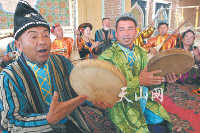| |
Twelve Muqam
( 2005-09-13 )
 Known as the "mother of Uygur music," the Twelve Muqam has a long history. Some scholars believe its origin can be traced back to the "Great Western Region Melody" that flourished during the Han (206BC-220AD) and Tang (618-907) dynasties and enjoyed a high popularity in Central China. Known as the "mother of Uygur music," the Twelve Muqam has a long history. Some scholars believe its origin can be traced back to the "Great Western Region Melody" that flourished during the Han (206BC-220AD) and Tang (618-907) dynasties and enjoyed a high popularity in Central China.
In the mid-16th century, aided by other musicians, the imperial concubine Amannisahan of the Yarkant Kingdom, who was also an esteemed poetess and musician, devoted all her efforts to collecting and compiling Muqam music, which was then scattered across Uygur-populated areas. She finally worked out 12 grand, yet light and entertaining compositions that are now known as the Twelve Muqam.
The Twelve Muqam are large-scale pieces consisting of sung poetry, stories, dance tunes, and instrumental sections. Some of the lyrics of the Muqam are drawn from the great Central Asian Chagatay poets. Others are drawn from folk poetry, especially the popular tale of the lovers Gh?rip and S?n?m.
The music of other ethnic groups is no match for the gigantic and neatly arranged system of the Twelve Muqam. Contemporary scholars refer to four distinct regional genres: the Twelve Muqam of theKashgar-Yarkand region, theTurpanMuqam, the Qumul Muqam, and the Dolan Muqam.
Strictly following the astronomical almanac, each of the Twelve Muqam is divided into three parts: Cong Naghma, Dastan, and Mashrap, each with 25-30 sub-melodies. The whole set of the Twelve Muqam consists of 360 different melodies and takes over 24 hours to play in full.
While Muqam is a musical form that has spread in Islamic areas throughout the world, the Twelve Muqam carries distinct Uygur characteristics. What is significant about its compilation is that Amannisahan did not borrow material from the wealthy and fully developed Arabian and Persian repertoires. Instead, she exploited the rich resources of Uygur folk music spread out in the wide area in the north and south of the Tianshan Mountains. As a result, the Twelve Muqam is especially distinct due to its strong Uygur flavor.
|
|

